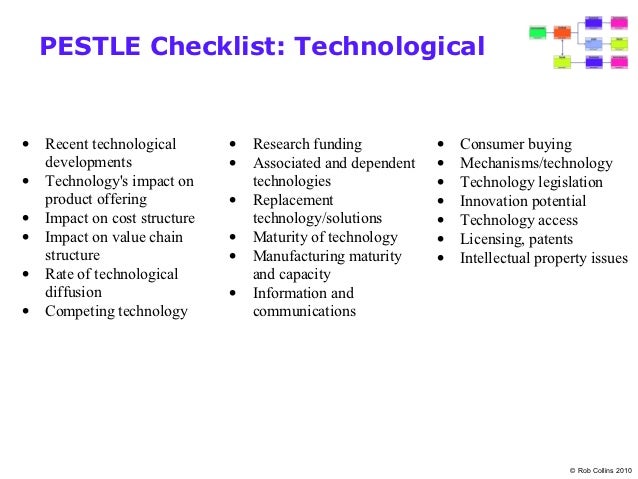
Cultural and religious rules influencingbusiness activity. Preferences for branded / unbranded products. Unemployment, availability of skilled labor. Development of relevant economic indicators. independence and efficiency of courts to enforce contracts. Regulation of transfer for capital and labour. These examples are not comprehensive they should be modified and complemented according of the actual subject of analysis. The following example shows some typical content of a PEST analysis. The PEST only refers to drivers from the organizations external environment. It seems to be a widespread problem to correctly distinguish between external and internal factors. In any case it is important to include only external factors which an organization cannot influence by itself. legislation as a political factor or ecological awareness as a socio-cultural factor. In industries that are less influenced by legal and ecological factors, they could be allocated to the other categories, e.g. In case such factors are of high relevance to an industry, they should be analyzed in the L and E section. Their importance differs from industry to industry. There are different opinions in literature about the inclusion of legal and ecological factors. PESTLE stands for political, economical, socio-cultural, technological, legal and ecological factors. While a PEST analysis looks at the market in general, SWOT analysis looks specifically at your business, both from the inside and outside, allowing you to see how well you are positioned in the market.The PEST or PESTLE is a useful starting point for the analysis of an organizations external environment and the forces at work there.

Once your PEST analysis is complete and you are more knowledgeable about your current market, you can easily move on to perform a SWOT analysis (also included in SmartDraw), determining the Strengths, Weaknesses, Opportunities, and Threats to your business.

Just start with one of the included PEST templates and customize it as a group by adding your factors. Smartdraw is so easy to use, you can bring it to your next workshop or brainstorming session, and, as a group, create a professional-looking PEST graphic that has the input of all your contributors, all in real-time.

The PEST acronym is sometimes reworked as STEP, and Smartdraw provides a template for a STEP diagram as well.
a strategic option, such as entering a new market or launching a new productįor a PEST analysis to succeed, it's critical to define scope so that the people contributing to the analysis and those interpreting the results from PEST analysis are able to understand the resulting implications.Ī PEST analysis can be an invaluable asset to your business, helping you identify the Political, Economic, Social, and Technological factors in the market so your company may build a sound strategic management plan. the product the company sells and its place in the market. In writing a good PEST, the subject should be a clear definition of the market being addressed, which may include issues such as: The four perspectives, which give a logical structure, provide a clear presentation for further discussion and proactive decision-making. Global, national and local economic conditions all contribute and affect how easy or difficult it is for a business to be successful, grow and be profitable as all of the conditions affect capital availability, cost, and demand as well as influence and impact supply and labor. The results are often used either to take advantage of potential opportunities and/or to make contingency plans for opposing threats when preparing business and strategic plans. The goal of PEST analysis is to examine the overall impact of each of these categories (and the potential or real correlation with each other) on the business. Two additional factors are also occasionally added to the analysis, environmental and legal, to make a broader PESTEL analysis, but these factors are not required to be separated into individual categorical analysis as they can easily be amalgamated within the other categories. These influences may include political, economic, social and technological forces often used in the environmental scope of this process. PEST analysis is a framework that categorizes macro-environmental influences in strategic planning.







 0 kommentar(er)
0 kommentar(er)
